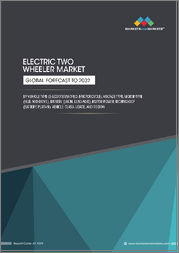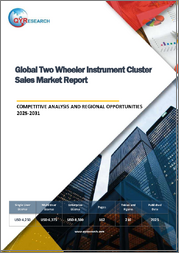
|
시장보고서
상품코드
1692147
아프리카의 이륜차 : 시장 점유율 분석, 산업 동향, 통계, 성장 예측(2025-2030년)Africa Two-Wheeler - Market Share Analysis, Industry Trends & Statistics, Growth Forecasts (2025 - 2030) |
||||||
■ 보고서에 따라 최신 정보로 업데이트하여 보내드립니다. 배송일정은 문의해 주시기 바랍니다.
아프리카의 이륜차 시장 규모는 2025년에 91억 5,000만 달러, 2029년에는 111억 1,000만 달러로 성장할 전망입니다. 예측 기간(2025-2029년)의 CAGR은 4.97%를 보일 것으로 예측됩니다.

아프리카의 이륜차 시장은 도시화와 지속가능한 운송 솔루션에 대한 수요에 견인되어 현저한 성장을 이루려고 합니다.
- 2023년 아프리카의 이륜차 시장은 탄력성과 성장을 보였으며 판매량은 188만대에 달했으며 2022년 185만대보다 개선되었습니다. 이 성장은 저렴한 가격, 다양한 지형에 대응할 수 있는 유연성, 전동 이륜차(E2W)를 포함한 지속가능하고 효율적인 모빌리티 솔루션에 대한 소비자의 관심이 높아짐에 따라 아프리카 대륙 전체에서 이륜차에 대한 의존도가 높아지고 있음을 부각하고 있습니다.
- 2024년 예측에서 판매량은 199만 대로 현저한 증가를 예상했으며, 이는 도시와 농촌 지역 모두의 교통 요구에 필수적인 차량으로서의 이륜차에 대한 왕성한 수요를 반영합니다. 교통안전 개선, 인프라 강화, 친환경 교통수단 촉진에 중점을 둔 아프리카 각국 정부의 이니셔티브는 이륜차 시장에 긍정적인 영향을 미칩니다. E2W에 대한 정책과 인센티브는 아프리카 대륙에 따라 다르지만 세계 동향과 지역 환경 목표에 맞추어 지속 가능한 이동성으로 점진적으로 변화하고 있습니다.
- 2024년부터 2030년까지 아프리카의 이륜차 시장은 크게 성장하고 예측 기간이 끝날 때 판매량이 232만 5,000대에 달할 것으로 예상됩니다. 이러한 성장이 예상되는 배경에는 도시화의 진전, 경제 개발, 이용하기 쉬운 교통 수단에 대한 절실한 요구가 있습니다. 기술, 저렴한 가격, 인프라 개선, 환경 유지에 대한 의식이 높아짐에 따라 E2W의 보급이 진행될 가능성이 있으며, 아프리카 전역에서 이륜차 시장이 다이나믹하게 확대되는 무대가 되고 있습니다.
아시아의 이륜차 시장은 도시화, 경제적 요인, 합리적인 가격으로 지속가능한 운송 솔루션에 대한 수요가 증가함에 따라 강력한 성장을 이루고 있습니다.
- 아프리카의 이륜차 시장은 도시화, 경제 개척, 경제적이고 효율적인 운송 솔루션에 대한 수요가 증가함에 따라 큰 성장을 이루고 있습니다. 아프리카 대륙의 도시가 계속 확대되고 있는 가운데, 이륜차는 자가용 차량을 대체하는 실용적이고 비용 효율적인 옵션으로서 대두해, 혼잡한 도시에서의 이동에 높은 기동성과 편리성을 제공합니다.
- 남아프리카의 이륜차 시장은 일관된 성장을 이루고 있으며 도시 모빌리티 솔루션 분야에서 매우 중요한 역할을 담당하고 있습니다. 2023년 판매량은 1만 5,620대에 이르렀으며 2022년 1만 5,120대에서 현저하게 증가했습니다. 이 증가는 합리적인 가격, 교통 체증을 회피하는 민첩성, 급등하는 연료비에 힘입어, 이륜차가 개인적인 이동 수단의 매력적인 대체 수단이 되어, 이륜차에 대한 관심이 국내에서 급증하고 있음을 의미합니다.
- 아프리카의 다른 지역의 이륜차 시장은 경제 성장과 지속 가능한 교통 수단에 대한 선호도가 높아짐에 따라 상승 기조에 있습니다. 2023년 이 시장 부문은 확대를 보였으며 판매량은 186만 6,540대와 2022년 183만 6,980대에서 완만하게 증가했습니다. 이 성장은 이륜차가 이 지역의 모빌리티 에코시스템에서 필수적인 역할을 하며, 다양한 지리적, 사회경제적 환경에서 합리적인 가격으로 이용하기 쉽고 효율적인 교통수단을 제공하고 있음을 뒷받침하고 있습니다.
아프리카 오토바이 시장 동향
아프리카의 수송전화는 급속히 확대되어 전차종에서 크게 증가
- 아프리카 운송 부문의 전기는 기세를 늘리고 있습니다. 2022년 승용차의 전동화율은 2%로, 2023년에는 4%로 상승했습니다. 소형 상용차(LCV)도 이에 이어 전기율은 2022년의 0.20%에서 2023년에는 1.09%로 상승했습니다. 많은 아프리카 국가에서 대중교통의 중요한 부분을 차지하는 버스의 전동화율은 2022년의 0.50%에서 2023년에는 1.96%로 급상승했습니다. 일부 지역에서 인기가 높은 교통수단인 이륜차도 전기율이 2022년 1.50%에서 2023년 4.65%로 비약적으로 상승했습니다.
- 지난 5년간 보다 친환경적인 운송 수단에 대한 아프리카의 노력이 밝혀졌습니다. 승용차의 전동화율은 2017년의 2%에서 2022년에는 5%로 상승했습니다. 아프리카 대륙 전역의 화물 수송에 빠뜨릴 수 없는 LCV의 전동화율은 2017년의 0.20%에서 2022년에는 2% 가까이까지 급상승했습니다. 대량 수송에 빠뜨릴 수 없는 버스는 2017년의 0.50%에서 2022년까지 3.42%로 현저한 진보를 이루었습니다. 한편, 매일 통근에 널리 사용되고 있는 이륜차의 전기율은 2017년의 1.50%에서 2022년에는 7.81%로 상승했습니다.
- 2024년부터 2030년까지의 기간을 전망하면 아프리카의 모든 차량 카테고리에서 전기화가 일관되게 성장할 것으로 예상됩니다. 2030년까지 전동 부품을 탑재한 승용차는 전체의 12%를 차지할 것으로 예측됩니다. LCV의 전동화율은 6%를 나타낼 것으로 예상되고 지속 가능한 도시간 이동에 빠뜨릴 수 없는 버스는 10년 후까지 전동화율이 10%를 나타낼 것으로 예측됩니다. 효율성과 합리적인 가격으로 알려진 이륜차 부문은 2030년까지 22%라는 상당한 전기화 속도를 달성할 예정입니다.
아프리카 오토바이 산업 개요
아프리카의 이륜차 시장은 중간 정도로 통합되어 있으며 상위 5개 기업에서 49.80%를 차지합니다. 이 시장 주요 기업은 다음과 같습니다. BMW Motorrad, Harley-Davidson, Honda Motor, KTM Motorcycles and Sym(sorted alphabetically).
기타 혜택
- 엑셀 형식 시장 예측(ME) 시트
- 3개월의 애널리스트 서포트
목차
제1장 주요 요약과 주요 조사 결과
제2장 보고서 제안
제3장 소개
- 조사의 전제조건과 시장 정의
- 조사 범위
- 조사 방법
제4장 주요 산업 동향
- 인구
- 1인당 GDP
- 자동차 구매를 위한 소비자 지출(cvp)
- 인플레이션율
- 자동차 대출 금리
- 전화의 영향
- EV 충전소
- 배터리 팩 가격
- Xev 신모델 발표
- 연료 가격
- 규제 프레임워크
- 밸류체인과 유통채널 분석
제5장 시장 세분화
- 추진 유형
- 국가명
- 남아프리카
- 아프리카
제6장 경쟁 구도
- 주요 전략 동향
- 시장 점유율 분석
- 기업 상황
- 기업 프로파일
- Bajaj Auto Ltd.
- BMW Motorrad
- Harley-Davidson
- Hero MotoCorp Ltd.
- Honda Motor Co. Ltd.
- KTM Motorcycles
- Lifan Technology(Group) Co. Ltd.
- Suzuki Motor Corporation
- Sym
- TVS Motor Company Limited
- Yamaha Motor Company Limited
제7장 CEO에 대한 주요 전략적 질문
제8장 부록
- 세계 개요
- 개요
- Five Forces 분석 프레임워크
- 세계의 밸류체인 분석
- 시장 역학(DROs)
- 정보원과 참고문헌
- 도표 일람
- 주요 인사이트
- 데이터 팩
- 용어집
The Africa Two-Wheeler Market size is estimated at 9.15 billion USD in 2025, and is expected to reach 11.11 billion USD by 2029, growing at a CAGR of 4.97% during the forecast period (2025-2029).

Africa's two-wheeler market is gearing up for significant growth, driven by urbanization and the demand for sustainable transportation solutions
- In 2023, the African two-wheeler market showcased resilience and growth, with sales figures reaching 1,880,000 units, marking an improvement from 2022's 1,850,000 units. This growth highlights the increasing reliance on two-wheelers across the continent, driven by their affordability, flexibility in navigating diverse terrains, and growing consumer interest in sustainable and efficient mobility solutions, including electric two-wheelers (E2Ws).
- The forecast for 2024 anticipates a notable increase in sales to 1,990,000 units, reflecting the robust demand for two-wheelers as essential vehicles for both urban and rural transportation needs. Governmental initiatives across various African countries, focusing on improving road safety, enhancing infrastructure, and promoting environmentally friendly transportation options, have positively impacted the two-wheeler market. While policies and incentives for E2Ws vary across the continent, there is a gradual shift towards sustainable mobility, aligning with global trends and local environmental goals.
- From 2024 to 2030, the African two-wheeler market is poised for significant growth, with projections indicating sales could reach 2,325,000 units by the end of the forecast period. This expected growth is likely to be propelled by ongoing urbanization, economic development, and the critical need for accessible transportation solutions. The potential increase in E2W adoption, driven by improvements in technology, affordability, and infrastructure, alongside a heightened awareness of environmental sustainability, sets the stage for a dynamic expansion of the two-wheeler market across Africa.
The Asian two-wheeler market is experiencing robust growth driven by urbanization, economic factors, and the rising demand for affordable, sustainable transportation solutions
- The African two-wheeler market is experiencing significant growth, driven by urbanization, economic development, and the increasing demand for affordable and efficient transportation solutions. As cities across the continent continue to expand, two-wheelers have emerged as a practical and cost-effective alternative to private cars, offering greater mobility and convenience in navigating congested urban areas.
- South Africa's two-wheeler landscape is witnessing consistent growth, positioning itself as a pivotal player in the realm of urban mobility solutions. The year 2023 witnessed a surge in sales, with figures reaching 15,620 units, a notable uptick from the 15,120 units sold in 2022. This escalation signifies a burgeoning interest in two-wheelers within the nation, fueled by their affordability, agility in navigating traffic congestion, and the escalating cost of fuel, which renders two-wheelers an alluring alternative for personal transportation.
- The Rest of Africa's two-wheeler market finds itself on an upward trajectory, propelled by economic growth and a growing inclination towards sustainable transportation preferences. In 2023, this market segment witnessed an expansion, with sales reaching an impressive 1,866,540 units, a modest increment from the 1,836,980 units sold in 2022. This growth underscores the indispensable role two-wheelers play in the region's mobility ecosystem, offering affordable, accessible, and efficient transportation solutions across diverse geographic and socio-economic landscapes.
Africa Two-Wheeler Market Trends
Africa's transport electrification is expanding rapidly, with significant increases across all vehicle types
- Electrification in Africa's transport sector is gaining momentum. In 2022, the electrification rate for passenger cars was 2%, which climbed to 4% in 2023. Light commercial vehicles (LCVs) followed suit, with their electrification rate rising from 0.20% in 2022 to 1.09% in 2023. Buses, a crucial part of public transport in many African countries, saw their electrification rate surge from 0.50% in 2022 to 1.96% in 2023. Even two-wheelers, a popular mode of transport in several regions, witnessed a significant uptick, with their electrification rate leaping from 1.50% in 2022 to 4.65% in 2023.
- Over the past five years, Africa's commitment to greener transportation has been evident. The electrification rate for passenger cars rose from 2% in 2017 to 5% in 2022. LCVs, crucial for goods transport across the continent, saw their electrification rate surge from 0.20% in 2017 to nearly 2% by 2022. Buses, pivotal for mass transit, made notable progress, going from a 0.50% rate in 2017 to 3.42% by 2022. Meanwhile, the electrification percentage for two-wheelers, widely used for daily commutes, climbed from 1.50% in 2017 to 7.81% in 2022.
- Looking ahead to the period of 2024-2030, all vehicle categories in Africa are expected to witness consistent growth in electrification. By 2030, passenger cars with electric components are projected to account for 12% of the total. LCVs are anticipated to reach a 6% electrification rate, while buses, crucial for sustainable urban and inter-city travel, are forecasted to hit a 10% electrification rate by the end of the decade. The two-wheelers segment, known for its efficiency and affordability, is set to achieve a significant electrification rate of 22% by 2030.
Africa Two-Wheeler Industry Overview
The Africa Two-Wheeler Market is moderately consolidated, with the top five companies occupying 49.80%. The major players in this market are BMW Motorrad, Harley-Davidson, Honda Motor Co. Ltd., KTM Motorcycles and Sym (sorted alphabetically).
Additional Benefits:
- The market estimate (ME) sheet in Excel format
- 3 months of analyst support
TABLE OF CONTENTS
1 EXECUTIVE SUMMARY & KEY FINDINGS
2 REPORT OFFERS
3 INTRODUCTION
- 3.1 Study Assumptions & Market Definition
- 3.2 Scope of the Study
- 3.3 Research Methodology
4 KEY INDUSTRY TRENDS
- 4.1 Population
- 4.2 GDP Per Capita
- 4.3 Consumer Spending For Vehicle Purchase (cvp)
- 4.4 Inflation
- 4.5 Interest Rate For Auto Loans
- 4.6 Impact Of Electrification
- 4.7 EV Charging Station
- 4.8 Battery Pack Price
- 4.9 New Xev Models Announced
- 4.10 Fuel Price
- 4.11 Regulatory Framework
- 4.12 Value Chain & Distribution Channel Analysis
5 MARKET SEGMENTATION (includes market size in Value in USD and Volume, Forecasts up to 2029 and analysis of growth prospects)
- 5.1 Propulsion Type
- 5.2 Country
- 5.2.1 South Africa
- 5.2.2 Rest-of-Africa
6 COMPETITIVE LANDSCAPE
- 6.1 Key Strategic Moves
- 6.2 Market Share Analysis
- 6.3 Company Landscape
- 6.4 Company Profiles
- 6.4.1 Bajaj Auto Ltd.
- 6.4.2 BMW Motorrad
- 6.4.3 Harley-Davidson
- 6.4.4 Hero MotoCorp Ltd.
- 6.4.5 Honda Motor Co. Ltd.
- 6.4.6 KTM Motorcycles
- 6.4.7 Lifan Technology (Group) Co. Ltd.
- 6.4.8 Suzuki Motor Corporation
- 6.4.9 Sym
- 6.4.10 TVS Motor Company Limited
- 6.4.11 Yamaha Motor Company Limited
7 KEY STRATEGIC QUESTIONS FOR VEHICLES CEOS
8 APPENDIX
- 8.1 Global Overview
- 8.1.1 Overview
- 8.1.2 Porter's Five Forces Framework
- 8.1.3 Global Value Chain Analysis
- 8.1.4 Market Dynamics (DROs)
- 8.2 Sources & References
- 8.3 List of Tables & Figures
- 8.4 Primary Insights
- 8.5 Data Pack
- 8.6 Glossary of Terms
샘플 요청 목록



















